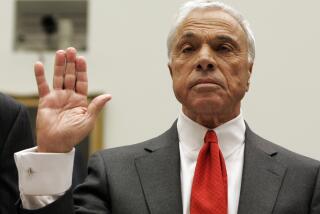Ex-S&L; Regulator Eyes Current Crisis and Says ‘I Told You So’
- Share via
From his balmy perch in south Florida, Edwin J. Gray is basking in the glow of favorable publicity about his efforts to warn the nation of the impending thrift industry crisis.
Gray’s tenure as the nation’s chief federal regulator for thrifts from 1983 to 1987 was a tumultuous one, marred by staff upheaval, travel expense scandals and unending complaints about Gray’s alleged inconsistency and incompetence as a regulator.
But as time passes, Gray is starting to look like a prophet in his own time for his repeated public warnings about the approaching dangers that eventually overwhelmed the industry and threatened its future.
“It is not only conceivable, but in my view very possible, that at some point in the future, massive infusions from the U.S. Treasury--and hence the American taxpayers--may well be necessary to shore up the system,” Gray told a gathering of savings and loan executives in Washington in 1984.
Gray’s dire warnings have proved unerringly correct. Hundreds of thrift failures, brought on by imprudent lending, have bankrupted the Federal Savings and Loan Insurance Corp. and forced the Bush Administration to come up with a taxpayer-assisted bailout proposal that is expected to cost at least $90 billion.
Once excoriated by some members of Congress, Gray now encounters lavish praise. Rep. James Leach (R-Iowa) recently called Gray “one of the great martyrs in this crisis” who “found out what the problem was and acted like any honest, prudent man should have acted.”
Gray’s past admonitions prompted Barron’s magazine to compare him to William Mitchell, the Air Force general who was ultimately court-martialed for insubordination in his fight to prove the superiority of air power some seven decades ago. Mitchell sought to show the vulnerability of ships to air attack.
“In many ways, Ed Gray . . . is a latter-day Billy Mitchell,” the magazine said. “Though, unlike Mitchell, Gray has lived to see his dire predictions come true.”
Now president of a savings and loan in Miami, Gray has labored tirelessly to remind lawmakers and reporters about his public statements.
He has compiled and distributed thick papers showing excerpts of his warnings going back to 1983.
Using typically colorful rhetoric in a letter last year to The Times, Gray said: “The world was on notice. Red lights were flashing. I was the messenger. The FSLIC crisis didn’t happen overnight, or in a vacuum. . . . Where was everybody when I was ringing the alarm bells?”
To be sure, Gray still has many critics, who say he was extremely difficult to deal with and a poor administrator with little executive experience. Gray is an erstwhile public relations man who worked for former President Ronald Reagan in both Sacramento and Washington before taking the regulatory job.
His warnings notwithstanding, detractors say it was Gray who failed to rein in fast-growing thrifts that later failed. “He’s rewriting history,” said California thrift executive Herbert M. Sandler.
In the end, history’s verdict on Gray is likely to be neither white nor black. As longtime thrift industry analyst Jonathan Gray put it: “The guy has been vindicated. It’s unfortunate that he was not adept politically.”
More to Read
Sign up for Essential California
The most important California stories and recommendations in your inbox every morning.
You may occasionally receive promotional content from the Los Angeles Times.













